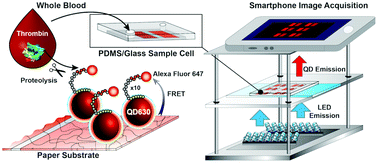Single-step bioassays in serum and whole blood with a smartphone, quantum dots and paper-in-PDMS chips†
Abstract
The development of nanoparticle-based bioassays is an active and promising area of research, where point-of-care (POC) diagnostics are one of many prospective applications. Unfortunately, the majority of nanoparticle-based assays that have been developed to date have failed to address two important considerations for POC applications: use of instrumentation amenable to POC settings, and measurement of analytes in biological sample matrices such as serum and whole blood. To address these considerations, we present design criteria and demonstrate proof-of-concept for a semiconductor quantum dot (QD)-based assay format that utilizes smartphone readout for the single-step, Förster resonance energy transfer (FRET)-based detection of hydrolase activity in serum and whole blood, using thrombin as a model analyte. Important design criteria for assay development included (i) the size and emission wavelength of the QDs, which had to balance brightness for smartphone imaging, optical transmission through blood samples, and FRET efficiency for signaling; (ii) the wavelength of a light-emitting diode (LED) excitation source, which had to balance transmission through blood and the efficiency of excitation of QDs; and (iii) the use of an array of paper-in-polydimethylsiloxane (PDMS)-on-glass sample chips to reproducibly limit the optical path length through blood to ca. 250 μm and permit multiplexing. Ultimately, CdSe/CdS/ZnS QDs with peak emission at 630 nm were conjugated with Alexa Fluor 647-labeled peptide substrates for thrombin and immobilized on paper test strips inside the sample cells. This FRET system was sensitive to thrombin activity, where the recovery of QD emission with hydrolytic loss of FRET permitted kinetic assays in buffer, serum and whole blood. Quantitative results were obtained in less than 30 min with a limit of detection 18 NIH units mL−1 of activity in 12 μL of whole blood. Proof-of-concept for a competitive binding assay was also demonstrated with the same platform. Overall, this work demonstrates that the integration of QDs with smartphones and other consumer electronics can potentiate bioassays that are highly amenable to future point-of-care diagnostic applications.


 Please wait while we load your content...
Please wait while we load your content...